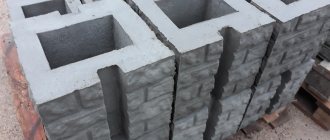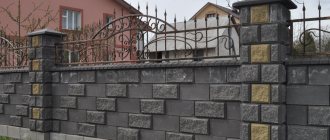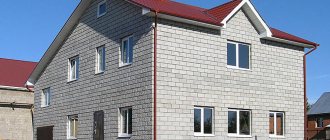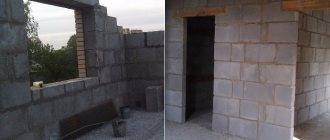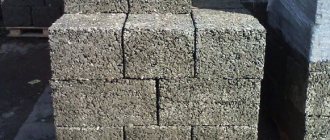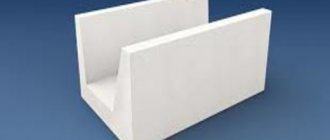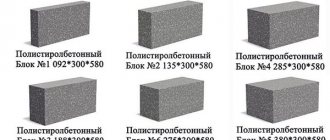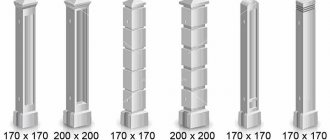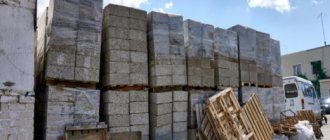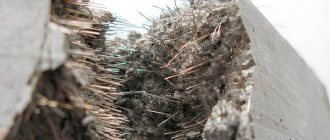Initially, concrete blocks appeared as an alternative to brick. Now they are very widely used in the construction market. Blocks can have a wide variety of shapes and colors. Among the areas of their use are the construction of supports, walls, and ceilings. Residential or technical structures can be built from concrete blocks. At the same time, you will not spend a lot of time, and the quality will be high.
Concrete blocks are often used to lay the plinths of wooden houses. Their reliability and durability are important qualities. For this reason, hangars, garages, bathhouses, etc. are made from them.
The price of the blocks is very low. But this does not negate such qualities as heat and sound insulation. Such qualities are simply necessary in the construction business.
Let's take a closer look at what types of concrete blocks can be found on the market and where they are used.
Types of concrete blocks
In fact, there are quite a lot of varieties of blocks of this type. It would be correct to use a classification of material according to the type of filler and composition as a whole. There are two large groups of concrete - heavy and light. Concrete blocks are made from them.
Heavy concrete blocks
Concrete is called heavy for a reason. Its dry density is 2500 kg per cubic meter. This is the material produced from such a solution.
Cinder blocks
This material has low thermal insulation and a high degree of moisture transmission. Because of this, structures made from it require additional insulation. Its advantage is its low price.
The main uses for cinder blocks are in the installation of interior and exterior walls.
Sand-concrete blocks
This material refers to hollow blocks reinforced with steel rods. For the most part, they are taken to build one-story structures. They are very durable. To build a residential structure from such material, M100 grade concrete is used in its manufacture.
There is another type of blocks of this type - solid, that is, monolithic. Hollow blocks are suitable for walls and partitions, and monolithic ones for foundations.
Reinforced concrete blocks
The peculiarity of these blocks is their metal frame, which gives the products additional strength. They are made from a concrete grade no worse than M100. They have grooves, which improves the connection of the blocks to each other.
The main purpose of such blocks is to build a foundation on different types of soil.
Lightweight concrete blocks
A feature of lightweight concrete is the use of lightweight aggregate in production, as well as the foaming of the binder element. In this way, it is possible to achieve a material density of 1800 kg per cubic meter or less. This group of blocks includes cellular blocks, which are easy to process. They are also lightweight, making them easy to handle.
Foam concrete
Made from sand, cement and foaming agent. Natural environmental conditions are used during the hardening process.
The material is used to build houses up to 2 floors.
Expanded clay concrete
This block is made from environmentally friendly materials. It contains baked clay, water and cement.
Walls built from this material are distinguished by good heat and sound insulation, and provide good air exchange in the room.
Aerated concrete
This material, popular in private construction, has a cellular structure. It contains quartz sand, lime and cement. Aluminum powder is used as a foaming agent.
The material has very light weight and low price. Therefore, it has become widespread in the construction of private houses.
There are classifications of blocks that divide the material by use:
- wall;
- foundation;
- septal, etc.
Characteristic advantages and disadvantages of reinforced concrete blocks
Any concrete block is made by vibration pressing. This technique guarantees the strength of the material and its ability to withstand significant loads. The main advantages of reinforced concrete products:
- strength;
- efficiency;
- ease of installation;
- low thermal conductivity;
- excellent thermal insulation;
- long-term operation;
- reduction of construction time;
- immunity to corrosion and moisture, sudden temperature changes;
- resistance to aggressive environments;
- variety of sizes and shapes.
Among the disadvantages inherent in these products, their heavy weight is noted. Because of this, during installation it is necessary to use special transport. The product is also quite expensive.
Dimensions and weight of concrete blocks
These parameters depend on the materials used and where the finished blocks will be used. GOST prescribes certain sizes, but in reality manufacturers can change them for individual orders.
When constructing external walls, blocks with the following dimensions are usually used:
- length 40 - 330 cm;
- height 30 - 390 cm;
- thickness 20-60 cm.
The dimensions of the blocks for internal walls are as follows:
- length 40-330 cm;
- height 30 - 330 cm;
- thickness 16-30 cm.
Probably the most popular size is: 200x200x400 mm. (20x20x40 cm).
The weight of the blocks may differ in the amount of material used for preparation, the brand of cement and the weight of the steel frame.
Monolithic wall blocks can weigh up to 20 kg, and hollow blocks - about 16 kg.
Foundation blocks can vary in weight much more. So monolithic blocks for the foundation weigh 300 - 2000 kg, blocks with voids up to 13% of the volume 500 - 700 kg, and hollow blocks 20 - 200 kg. These parameters depend on the material. This means that the price of concrete blocks for the foundation will depend on it.
Concrete stones and small blocks
Concrete stones and small blocks are made from mineral binders. Using them for laying walls instead of bricks gives a significant economic effect, since due to the large size of the stones and blocks, high productivity of the mason is achieved; Moreover, the cost of 1 m of stones and blocks is lower than the cost of the same amount of bricks.
Concrete wall stones for load-bearing and enclosing structures of all types of buildings are made with dimensions from 288 x 138 x 138 to 390 x 190 x 188 mm, weighing no more than 32 kg, from heavy and light concrete with cement, silicate and gypsum binders. They are used for laying external walls (ordinary and front) and foundations. Wall stones with a concrete density of more than 1600 kg/m3 must be hollow. For foundations, stones are made only from heavy concrete without voids. Face stones can have a relief design or a coating of decorative aggregate. Stones are divided into seven grades: from 25 to 200. Stones of grades 25 and 35 are produced from lightweight concrete with porous aggregates. Stone grades for frost resistance: F15, 25, 35 and 50.
Small wall blocks made of cellular concrete are widely used for laying external and internal walls of low-rise buildings and filling the frame of multi-storey buildings. The blocks are recommended for use in rooms with a relative humidity of no more than 75%. For the walls of basements, plinths and other parts of buildings where the concrete may be heavily moistened, such blocks are prohibited. They are made from cellular concrete.
Rice. 14.3. Concrete stones
Depending on the average density of cellular concrete (kg/m2), blocks are produced in eight grades: from D500 to D1200. Concrete class for compressive strength (MPa), respectively, from B1.5 to B 12.5, conductivity at 8% humidity from 0.2 to 0.37 W/(m * K) (see paragraph j 2.7). The frost resistance of blocks for external walls must be at least F25, and for blocks for internal walls - F15.
The standard provides 10 standard sizes of blocks from 300 x 250 x x 300 mm to 300 x 200 x 600 mm (nominal dimensions). The blocks are produced for masonry with mortar or glue (the second option is more effective in terms of ensuring the thermal insulation properties of the wall by reducing the thickness of the seams). The difference between these two types of blocks lies in the size and accuracy of their observance. Thus, the permissible curvature of edges and edges for blocks for masonry with mortar is 5 mm, and for blocks for masonry with glue - 1 mm; Accordingly, the calculated thickness of the mortar joint is 12 mm, and the adhesive joint is 2 mm.
The big advantage of cellular concrete blocks is their low density (usually 500...600 kg/m3), thanks to which they can be used to build walls 30...40 cm thick without additional thermal insulation and at the same time meeting SNiP standards for thermal resistance.
In low-rise construction, blocks can be used for load-bearing walls, and in multi-storey construction - as filler for the building frame.
Concrete paving elements (concrete paving slabs) are used to construct sidewalks, squares, and garden paths. They are produced from fine-grained cement concrete with a composition of 1:1:1.5 (cement consumption 500...600 kg/m3 of concrete) in two ways: vibrocompression from rigid mixtures and vibrocasting from plastic mixtures using plasticizers (for example, C-3). Due to the low water content in both cases, concrete of high strength (at least 30 MPa) and high frost resistance (at least F200) is obtained with a water absorption of no more than 5%.
Concrete paving elements have a variety of shapes and colors, in particular, they can imitate paving stones made of natural stone (diabase, sandstone, dolomite, etc.).
Concrete paving slabs are a technologically advanced material that allows paving paths and areas of any size and configuration.
A tile covering on a sandy base has a number of advantages compared to a continuous asphalt covering: - puddles do not form on such a covering, since water flows freely through the gaps between the tiles; — such a coating does not violate the need of green spaces for water and gas exchange, which is beneficial for the ecology of the surrounding space; — if it is necessary to carry out repair work (for example, laying underground communications), paving slabs can be easily removed, the necessary work carried out and laid again; — in the summer, the heating of light-colored tiles is significantly less than that of dark asphalt; At the same time, the tile coating does not soften and does not emit volatile products.
In addition to tiles, decorative cement concrete can be used to produce a variety of garden design elements.
Read more: Wood-cement materials Asbestos cement and asbestos-cement materials Gypsum and gypsum concrete products Sand-lime brick and silicate concrete products General information about artificial stone materials
Concrete block laying
This type of block is laid using standard bricklaying technology. It has several differences. Such, for example, as:
- The blocks from which the walls of the house are built are placed not on a mortar, but on a special glue.
- Before laying a row of blocks, it is necessary to clean their surface and moisten it a little.
- After laying the block, its surface must be leveled using a grater so that the top block lies evenly and tightly.
- When laying a concrete block, dressing must be observed. The overlap must be at least 30% of the block.
Price of concrete blocks
Now about how much concrete blocks cost. The main factor that determines the price of such material is the type of block. The blocks differ in composition and production method. The price also depends on the dimensions of the blocks.
For example, the cheapest concrete block is considered to be a cinder block. Its price is about 35 rubles/piece. Hollow expanded clay concrete 400x250x200, will cost 3100 rubles. per cubic meter. Full-bodied 3700 per cubic meter. Aerated concrete 625x400x250 will cost from 3900 per cubic meter.
